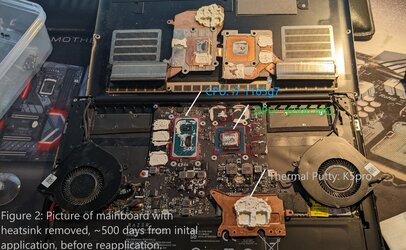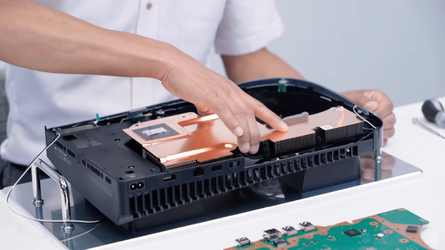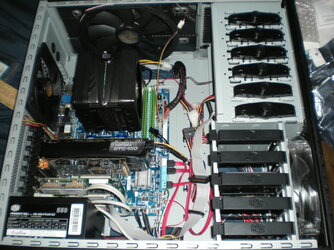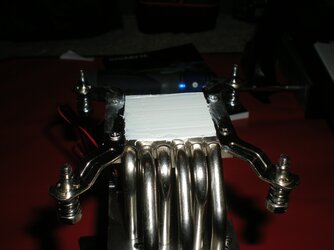Okay, so we all know that liquid metal thermal interface material (TIM) can be used to make some sick performance gains, especially in laptops. But there's some anecdotal evidence to suggest it needs to be reapplied, when used with naked copper, anywhere between 3 months and 1 year.
But how much of a difference does reapplying actually make?
Based on my experience, with my late 2020 Razer Blade Stealth, it was found that after ~500 days from initially applying Conductonaut to the CPU and GPU, performance significantly improved (p = 9.619e-11) after reapplying, as seen in Figure 1.
To test this, 4 benchmarks were used; CinebenchR20, TimeSpy Extreme, Fire Strike, and Rainbow 6 Seige. Each one was tested 3 times, before and after reapplication, with ~60 seconds between each run. All testing was done in an air-conditioned room, standardised to 100% fan speed. Furthermore, the average CPU and GPU temperature, during each run, was recorded using Hardware Info.
From this, it was found that GPU temperatures significantly decreased (p = 0.03302), from a mean of 56.4̇̇ °C to 46.1̇̇ °C, which likely contributes to the improved scores, especially in GPU-centric benchmarks such as TimeSpy Extreme, which increased by an average of 2.3%.
However, CPU temperatures insignificantly increased (p = 0.5963) by an average of ~1 °C, going from 52.5 °C to 53.6̇̇ °C. Yet Cinebench scores still increased by an average of ~0.5%. I would speculate that this is because little ion migration could be seen on the CPU side of the heatsink, as pictured in Figure 2. Although, what ion migration that is visibly present, is unevenly distributed across the CPU die. Therefore, perhaps the areas without the TIM, in a liquid state, were holding back the CPU overall, even if this is not being accurately reported in software, as during initial inspection, all the individual core temperatures were quite even. This may have also been further exaggerated by technician error, as the thermal pad, between the CPU side of the heatsink and the aluminium back panel, was not properly reapplied before secondary testing.
So yeah, reapplying your liquid metal after a while can make for some improvements. Results may vary. Perhaps testing with NaK may give more explosive results?
But how much of a difference does reapplying actually make?
Based on my experience, with my late 2020 Razer Blade Stealth, it was found that after ~500 days from initially applying Conductonaut to the CPU and GPU, performance significantly improved (p = 9.619e-11) after reapplying, as seen in Figure 1.
To test this, 4 benchmarks were used; CinebenchR20, TimeSpy Extreme, Fire Strike, and Rainbow 6 Seige. Each one was tested 3 times, before and after reapplication, with ~60 seconds between each run. All testing was done in an air-conditioned room, standardised to 100% fan speed. Furthermore, the average CPU and GPU temperature, during each run, was recorded using Hardware Info.
From this, it was found that GPU temperatures significantly decreased (p = 0.03302), from a mean of 56.4̇̇ °C to 46.1̇̇ °C, which likely contributes to the improved scores, especially in GPU-centric benchmarks such as TimeSpy Extreme, which increased by an average of 2.3%.
However, CPU temperatures insignificantly increased (p = 0.5963) by an average of ~1 °C, going from 52.5 °C to 53.6̇̇ °C. Yet Cinebench scores still increased by an average of ~0.5%. I would speculate that this is because little ion migration could be seen on the CPU side of the heatsink, as pictured in Figure 2. Although, what ion migration that is visibly present, is unevenly distributed across the CPU die. Therefore, perhaps the areas without the TIM, in a liquid state, were holding back the CPU overall, even if this is not being accurately reported in software, as during initial inspection, all the individual core temperatures were quite even. This may have also been further exaggerated by technician error, as the thermal pad, between the CPU side of the heatsink and the aluminium back panel, was not properly reapplied before secondary testing.
So yeah, reapplying your liquid metal after a while can make for some improvements. Results may vary. Perhaps testing with NaK may give more explosive results?




